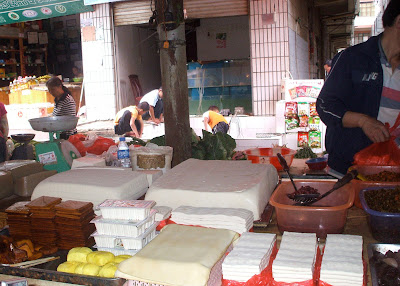
Hey Folks. Long time, once again, since my last post. I'm gonna try and be a better blogger, I promise.
Last month, I finally joined "The Daring Bakers." It's a really fun blog list that gives little baking addicts, like myself, an excuse to bake one particular item every month. Sometimes it's a traditional but hard-to-make item like last month's croissants. Other times, it's a not-as-hard-to-make but slightly rarer item like this month's: Povitica.
Povitica is an Eastern European, filled, yeasted coffee cake, somewhat akin to a babka. There are definitely differences, however, and both are fun to make in their own way. For this month's "challenge," we daring bakers were asked to bake one povitica with a traditional walnut filling, and we were welcome to play around with other fillings of our own. I opted for a variation on the walnut with a southern twist-- praline. (This year's pecans are just now being harvested, and we picked up a bag att yesterday's farmers' market.) All in all, the potivica was a really fun project...although I don't think it could ever really replace chocolate babka.
The main recipe used by all daring bakers can be found here. I made a few small changes. I used skim milk mixed with a touch of cream in place of the whole milk, and when I rolled out the dough, I sprayed it with pam rather than putting more butter on top. I also used salted butter and decreased the salt in the recipe slightly.
This is my filling recipe, prepared the same way as the traditional:

Praline Filling Ingredients (for 1 loaf)
-1 3/4 c. ground pecans
-1/4 c. milk
-1/4 stick butter
-1 beaten egg yolk
-1/2 c. packed brown sugar, plus 1-2 TBS white sugar
-1/4 tsp. butter extract
Potivica is prepared much like any other yeasted sweetbread at first. Yeast, milk, eggs, sweetener, oil or butter, flour, kneading...a good recipe for yum.
After the rising, it's rolled out to a small-pizza sized round, and then really rolled out until it's almost paper-thin.
(As you can see, I didn't quite get that far.)
After the rolling, it's time for the filling. I actually ended up using my hands for this, after I spooned it on, to make it nice and even.
The loaves are rolled up, carpet-style, and then twisted in upon themselves in the loaf pans. I didn't get mine quite as swirly as I'd hoped, but I was worried I'd break them if I kept tugging.
After the loaves come out, they have to cool for quite awhile or they'll turn to crumbly gook when sliced.
Mmmmmmm....potivica.




















